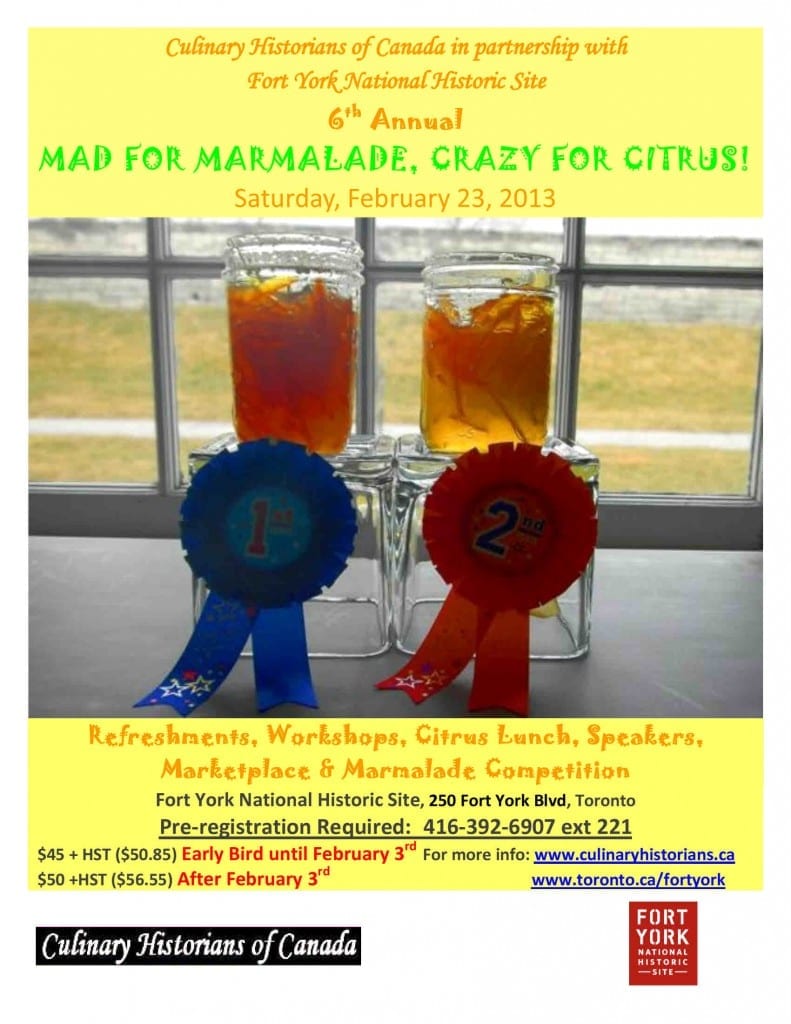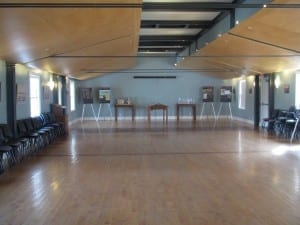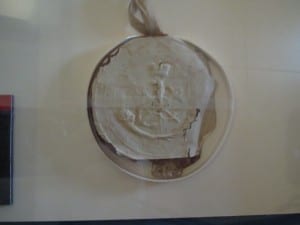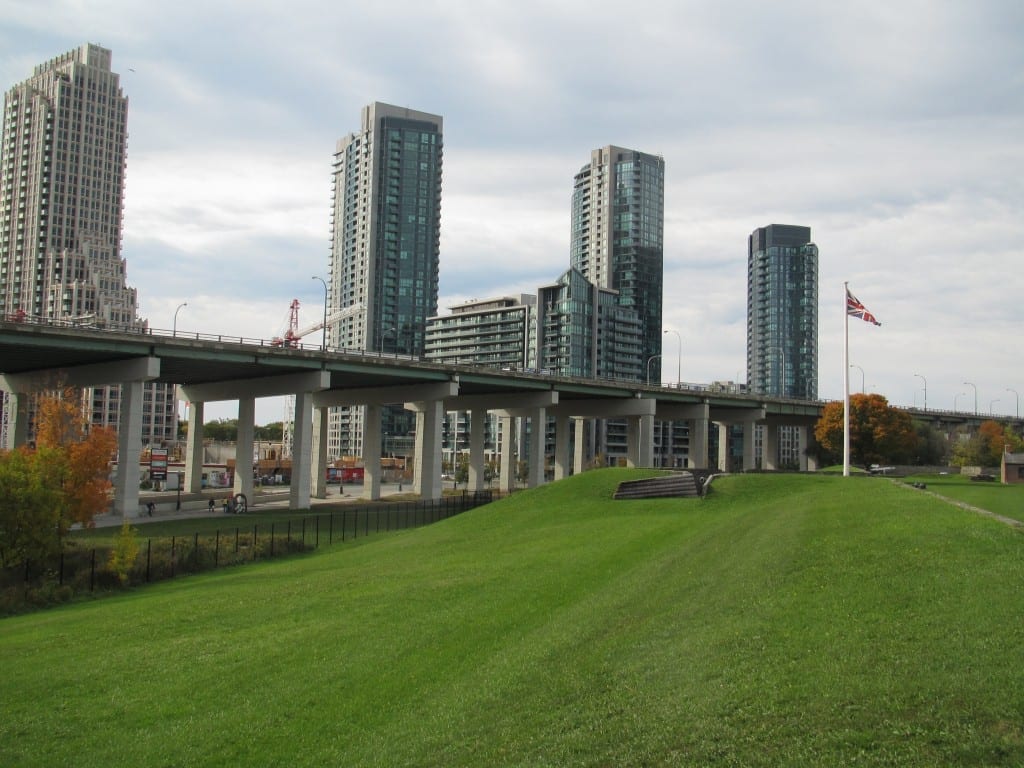Mad for Citrus – special event taking place at Fort York on Sat., Feb. 23, 2013
The following message is from Elizabeth Quance of Friends of Fort York:
This message is to let you know about a special event taking place at the Fort on Saturday, February 23: the 6th annual Mad for Marmalade, Crazy for Citrus.
If you live in the Greater Toronto Area and you have a passion for marmalade, you will want to attend this event. Workshops and demonstrations will educate you on the finer points of marmalade, using 18th and 19th century recipes from the Fort York kitchens
Elizabeth Quance
Secretary, Friends of Fort York
Registration flyer:
2013 Mad for Marmalade Registration Flyer-Final
[Click on the above-noted link to access the eight-page registration flyer.]
[End of message]
Among links of relevance:
Isaac Brock mini-exhibit – October 2012
I’m reminded, with regard to Fort York, of a mini-exhibit that was held at Fort York from Oct. 12 to 14, 2012, and which I had the good fortune to attend.
As a notice mentioned at the time, the mini-exhibit looked at the career of Isaac Brock and his legacy in Canada. “Among the rare artifacts on display,” the notice indicated, “is the charge of arms granted to Brock in 1813, an object never before exhibited to the public.”
An online series of from the March 2012 issue of The Walrus provided an overview of the context of the mini-exhibit.
A Dec. 21, 2012 Toronto Star article provides an additional overview. The article is entitled: “Nothing to celebrate at Fort York during War of 1812: The hostilities of 1812 put a tight squeeze on products coming in to Fort York, making for a dismal Christmas.”
Few people were there on the day I visited the exhibition. What is occasionally described as the relative obscurity of Fort York, which this Aug. 24, 2012 Globe and Mail article chooses to present as a source of mystification, is to my mind one of its enduring and inspiring features.
A City of Toronto webpage provides additional background about the fort, as does an article at the spacing.ca website. As the latter webpage notes, in the 1950s Fort York was nearly paved over to make way for the Gardiner Expressway, but planners eventually rerouted its path south of the grounds of the fort. The saving of the site from displacement by the expressway can be viewed, I believe, as a significant achievement.
Still another context for the understanding of the War of 1812 may be found in other blog posts at the Preserved Stories website dealing with military history. This blog post focuses in particular on the life of the British soldier in previous centuries.
Greenspace surrounded by condo towers
On the day that I attended the Isaac Brock mini-exhibit in October 2012, few other people were about. Yet I felt perfectly at home. I enjoy empty greenspaces, including the greenspace where the archaeological remains of the Colonel Samuel Smith homestead site are located, as I’ve outlined on the landing page of my website.
Fort York features another such greenspace. Relatively few such empty spaces of this nature remain in Toronto. The Fort York version is a delightful greenspace, nestled within a perimeter of condo towers. It’s a noisy space, given that it’s adjacent to the Gardiner Expressway. For that reason, perhaps, the greenspace is not a place where I would like to spend endless hours.
When you’re travelling along the Gardiner Expressway, you can sense an empty space, barely visible, where Fort York is located. A flag pole, some trees, and an absence of condo towers are indications of the presence of the fort, built along the former shoreline (now some distance north of the current shoreline) of Lake Ontario.
It’s something to look for, in the event you’re moving at 5 km/h on the Gardiner during a traffic jam. If going faster, better to just ignore it and keep your eyes on the road.
Traffic: Why we drive the way we do (and what it says about us) (2008)
The best way, I would add, to sense the presence of the fort while driving on the expressway is by looking at it while you’re in a passenger seat.
As this Feb. 1, 2013 Globe and Mail article notes regarding driving distractions, “In 2011, according to the U.S. National Highway Transportation Safety Board, 3,331 people in the United States were killed in crashes involving a distracted driver.”
It’s unwise, that is, to look away from the forward roadway when you’re in the driver’s seat. Tom Vanderbilt (2008) refers, in this context, to the “the largest study to date of the way we actually drive today” (p. 77).
The study, by the Virginia Tech Transportation Institute (VTTI), “equipped one hundred cars in the Washington, D.C. and northern Virginia area with cameras, GPS units, and other monitoring devices, and then set about recording a year’s worth of what it calls ‘pre-crash, naturalistic driving data.'”
The study found that “almost 80 percent of crashes and 65 percent of near crashes involved drivers who were not paying attention to traffic for up to three seconds before the event.”
“That period is crucial,” Vanderbilt adds. “‘A total time of two seconds looking away from the forward roadway is when people start to get in trouble,’ explained Shelia ‘Charlie’ Klauser, a researcher at VTTI and the study’s project manager. ‘That’s when they get to the point when they are starting to lose track of what’s going on in front of them.’
“The two-second window is not technically related to the ‘two-second rule’ for following distance, but the comparison is instructive. The point is that a lot can happen in two seconds – like colliding with a car in front if it came to a stop or slowed – but drivers, lulled by the expectancy that it will not stop, drive as if the world will not have changed when they return their eyes to the road after that two seconds” (pp. 77-78).
“I however speak loud and look big”
At the October 2012 Fort York mini-exhibit, I enjoyed reading the story of Isaac Brock.
“To inspire those around him,” a display panel notes, “Brock led from the front: “most of the people [of this province] have lost all confidence, I however speak loud and look big.” At Detroit, he rode his horse at the head of the British troops approaching the American defences. At Queenston, he was leading a counterattack by the 49th Foot and Upper Canadian militia on the American position when he was mortally wounded.”
When I left Fort York, I stopped at the gift shop and bought some cookies, made according to a historic recipe dating from around the 1800s. I really enjoyed the cookies. When I go back I will buy more. I very much like the idea of an event at Fort York, as on Feb. 23, 2013, centred around marmalade, using historic recipes from the Fort York kitchens.
More information on historic recipes is available at http://culinaryhistorians.ca






Leave a Reply
Want to join the discussion?Feel free to contribute!